Table of contents
- 2019 off-road tires for travel enduros in the test For the compromise between terrain and road
- Bridgestone AX 41
- Continental TKC 80
- Metzeler Karoo 3
- Michelin Anakee Wild
- Mitas E-07+
- Pirelli Scorpion Rally
- Off-road motorcycle tires on the country road
- Off-road motorcycle tires off-road
- Off-road motorcycle tires in the wet test
- Off-road motorcycle tires in the wear test
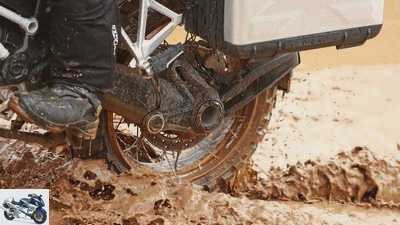

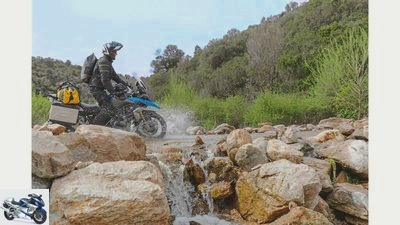
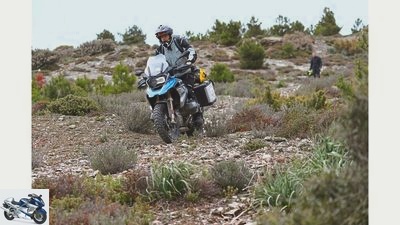

17th pictures
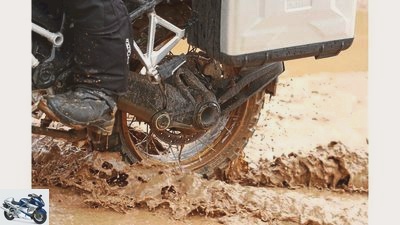
Markus Jahn
1/17
The Bridgestone Battlax AX 41 is the tip for off-road-oriented travel endurists.
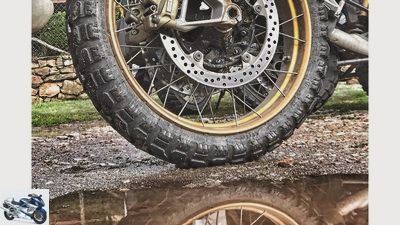
2/17
Even after more than three decades, the Continental TKC 80 impresses with its balance.
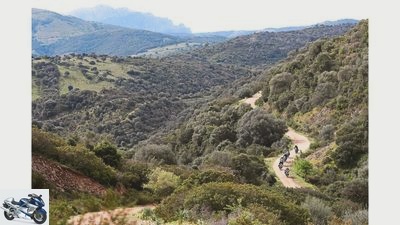
3/17
The Metzeler Karoo 3 does a good job on the road.

4/17
With its top performance, the Michelin Anakee Wild is configured for off-road use.

5/17
The Mitas E-07 + stands for the combination of street performance and robust appearance.
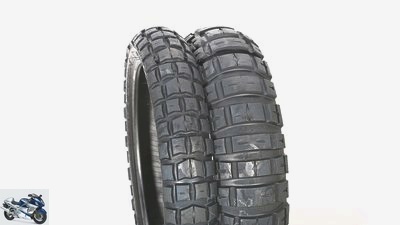
6/17
The Pirelli Scorpion Rally impresses with its brilliant balance.
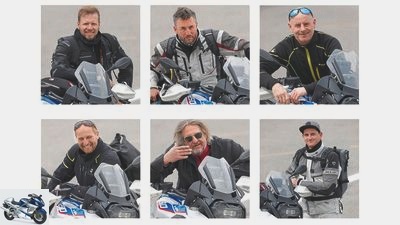
7/17
The testers at the MOTORRAD enduro tire test 2019 (from top left to bottom right): Sebastian Schmidt, Sven Loll, Karsten Schwers, Jorg Lohse, Gabriel Winter and Timo Morbitzer.
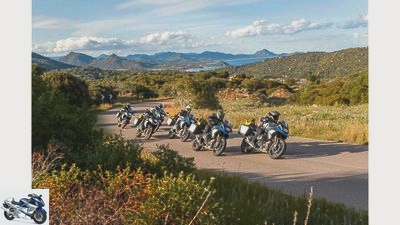
8/17
There is a clear purchase recommendation for everyone who is primarily looking for a coarse-grained vehicle for the road: The very precise Mitas works excellently, with rubbers from Metzeler and Pirelli positioned just behind it.

9/17
In the area, Michelin’s wild anakee shows the competition red – in the form of the rear light, which keeps running out of the dust.

10/17
With a minimal gap, Bridgestone’s new AX 41 impresses as a sovereign off-roader.

11/17
Conti’s classic TKC 80 also remains a very good option for off-road enthusiasts.

12/17
Two essential findings in advance: The best road tire (Mitas) is by no means the best in bad weather.

13/17
And anyone who can cope with mud and greasy rubble (Michelin) has by no means pulled the trump card for wet tar roads.

14/17
Grobstoller are faster at their limit in the rain than smoother, profiled enduro tires.

15/17
On our 1,500 kilometer tour we also discovered the most godforsaken corners of Sardinia.

16/17
When refueling it was always: times six! 600 liters of fuel ran through.

17/17
With the new large enduro bikes, the tire dimensions 120 / 70-19 (front) and 170 / 60-17 (rear) have become the measure of all things. However, the new tires are increasingly tailored to the wider sizes, which is why we use the corresponding new vehicles for tests.
accesories
tire
Tested off-road tires for large travel enduros
2019 off-road tires for travel enduros in the test
For the compromise between terrain and road
For the 2019 off-road motorcycle tire test, we strap 6 pairs of off-road tires to 6 BMW R 1250 GS and do the off-road, country roads, wetness and wear test.
Jorg Lohse,
Karsten Schwers
07.06.2019
Let’s not write around the bush for a long time: No, there is no universal weapon à la “one size fits all” in the category of off-road motorcycle tires for large travel enduros. Of course, you could choose the overall winner based on points. That would be the Pirelli Scorpion Rally. But where there is a first, there is also a last, and that would be Michelin Anakee Wild. But: Anyone who absolutely wants to pick the most suitable off-road tire from the “On- / Offroad” tire range cannot ignore the Michelin. Anyone who combines a robust look with top-notch street performance reaches for the Mitas. Bridgestone delivers a solid mix of off-road, wet and mileage, Conti moves particularly well on asphalt and gravel. In total, we have six tires here for individualists. And that’s good.
Buy complete article
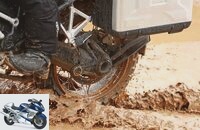
2019 off-road tires for travel enduros in the test
For the compromise between terrain and road
Pages) as PDF
€ 2.00
Buy now
Bridgestone AX 41

Markus Jahn
The Bridgestone Battlax AX 41 is the tip for off-road-oriented travel endurists.
Weight: front 5.3 kg, rear 7.6 kg
Speed index: Q (up to 160 km / h)
Country road / everyday life (104 points, 5th place): A look at the profile raises doubts that the new AX 41 will impress on asphalt. And this is how it is: In tight bends, the off-roader looks slightly wobbly, when accelerating and at higher speeds, walking movements are disruptive. Above 80 km / h, the rolling noise increases significantly.
Off-road / terrain (124 points, 2nd place): Off the road, the AX impresses with great performance, meshes strongly with gravel and scree, scores when braking off-road.
Wet test (74 points, 3rd place): In the rain, the Bridgestone gives an easily assessable feedback and pleases with ample adhesive reserves. Disadvantage: the braking performance!
Wear and tear (78 points, 3rd place): With its coarse studs, the AX offers a lot of attack surface, but it can withstand the stress test in the road and off-road mix.
Conclusion: A tip for off-road-oriented travel endurists. The disadvantages on paved slopes are limited, on the plus side there are sovereign off-road performance, sufficient grip in the rain and low wear values.
MOTORCYCLE Rating: Good
Continental TKC 80
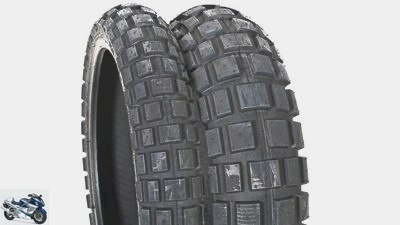
Even after more than three decades, the Continental TKC 80 impresses with its balance.
Weight: front 4.5 kg, rear 6.7 kg
Speed index: Q (up to 160 km / h)
Country road / everyday life (116 points, 4th place): The TKC is more convincing on paved roads than the similarly broadly profiled competitors from Bridgestone and Michelin, but the bottom line is still reasonably harmonious and neutrally controllable. Braking performance, straight-line stability and driving noises are also better.
Offroad / Terrain (117 points, 3rd place): “look and feel” fit here. The Grobstoller feels right at home in rough terrain. Bridgestone and Michelin drivers are only ahead of the game when it gets really hearty.
Wet test (67 points, 5th place): When it rains, you can now feel that the TKC is the grandfather in the field. The competition scores with more grip and is easier to assess.
Wear (80 points, 1st place): The rubber is shrinking at the back, but not at the front. So that the winner in the chapter “Profitability”.
Conclusion: Even after more than three decades, the classic in the segment doesn’t really look old and impresses with its balanced properties on asphalt, top off-road performance and the best wear values.
MOTORCYCLE Rating: Good
Metzeler Karoo 3
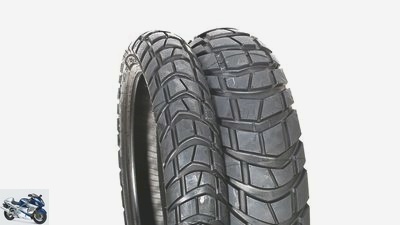
The Metzeler Karoo 3 does a good job on the road.
Weight: front 5.4 kg, rear 7.6 kg
Speed index: T (up to 190 km / h)
Country road / everyday life (120 points, 3rd place): The tunnel design points in the direction of the road, which can actually be felt. On asphalt, the Karoo 3 scores with good adhesive reserves, its handiness and stability in curves particularly appeals to sporty endurance travelers. A small pitching impulse can be felt when braking in an inclined position.
Off-road / terrain (106 points, 5th place): The Metzeler no problems, it also masters uphill sections with good interlocking. However, it cannot keep up in rougher terrain or on mud.
Wet test (83 points, 2nd place): good grip, well-balanced limit range, great braking values. A tire for rainy days.
Wear and tear (74 points, 4th place): It fits in the front, but there is plenty of profile behind. Overall mixed
Conclusion: The direction of travel of the Karoo 3 points clearly in the direction of the road, where it does a good job even in adverse conditions, for example in the rain or on gravel. Serious off-road rides are not his thing, however.
MOTORCYCLE Rating: Good
Michelin Anakee Wild
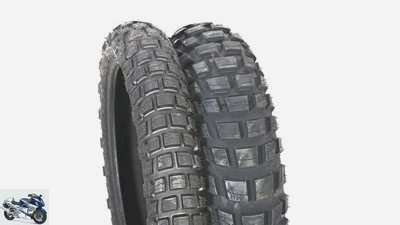
With its top performance, the Michelin Anakee Wild is configured for off-road use.
Weight: front 5.2 kg, rear 6.5 kg
Speed index: R (up to 170 km / h)
Country road / everyday life (97 points, 6th place): The way into the terrain has to be fought for, the Anakee Wild does not cut a particularly good figure on asphalt roads – wobbly in sloping positions, clearly noticeable flexing movements when accelerating and in curves, plus only moderate stability and an overall very subdued braking performance.
Off-road / terrain (129 points, 1st place): Fine gravel or coarse scree, uphill or downhill, mud passages or wet meadow slopes – the Michelin-tyred travel enduro feels right at home in this terrain. Top!
Wet test (61 points, 6th place): Still okay when braking in the rain, otherwise the grip reserves in the wet are very poor.
Wear and tear (71 points, 5th place): The coarse lugs wear off particularly quickly when scrubbing for kilometers on and off the road.
Conclusion: The top performance off-road is beyond any doubt. For this, many disadvantages have to be accepted in everyday use on “normal” roads. The Anakee Wild is configured to be very pointed for an on / off-roader.
MOTORCYCLE Rating: satisfying
Mitas E-07+
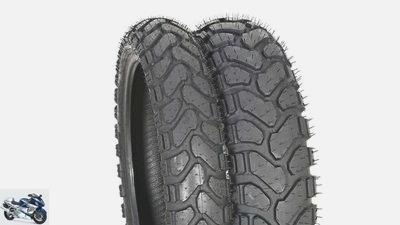
The Mitas E-07 + stands for the combination of street performance and robust appearance.
Weight: front 5.8 kg, rear 8.0 kg
Speed index: T (up to 190 km / h)
Country road / everyday life (125 points, 1st place): With its neutral steering behavior, sufficient stability and confident appearance when braking, the Mitas of the competition in this test chapter. Thanks to the low flexing movements, the speed index can easily be maxed out to the limit of 190 km / h, and with its moderate rolling noise, the E-07 + also scores in the comfort rating.
Off-road / terrain (88 points, 6th place): The road-oriented profile with a low negative proportion quickly reaches its limits off gravel roads due to a lack of traction.
Wet test (72 points, 4th place): Especially at the back, the reserves are quickly used up. The feedback when it is wet is okay.
Wear (79 points, 2nd place): The large tread blocks are particularly tough and robust at the back. Well done!
Conclusion: If you want to combine street performance with a robust look, you should reach for the newcomer from Mitas. The E-07 + is convincing on-road when it comes to wagging bends, but off-road the terrain must not be too rough. Top in wear.
MOTORRAD verdict: Good
Pirelli Scorpion Rally

The Pirelli Scorpion Rally impresses with its brilliant balance.
Weight: front 5.5 kg, rear 7.5 kg
Speed index: T (up to 190 km / h)
Country road / everyday life (121 points, 2nd place): Its easy turning behavior, the full grip cushion, low rolling noise and good feedback make the Pirelli off-roader a very good road tire. The straight-line stability also impresses with above-average stability. With its slight tendency to wobble, compromises have to be made in terms of steering precision.
Offroad / Terrain (111 points, 4th place): On loose terrain, the Pirelli literally shovels through the ground. Particularly great: the stable front tire. There’s a problem in the mud.
Wet test (84 points, 1st place): Broad, easily assessable limit area plus plenty of grip. A tip for the rainy season!
Wear and tear (71 points, 5th place): Severe overexploitation of the tread blocks in front and behind. The performance costs mileage.
Conclusion: Its balance clearly makes it one of the best on / off-road tires in this test field. Brilliant performance on the road paired with good terrain characteristics and a top performance on wet asphalt.
MOTORRAD verdict: Good
Off-road motorcycle tires on the country road
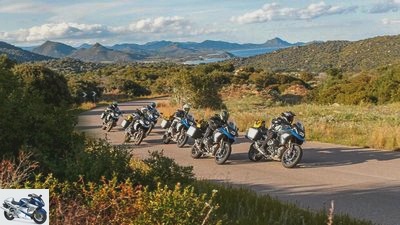
Buy recommendation for everyone who is primarily looking for a coarse-grained vehicle for the road: The very precise Mitas works excellently, with rubbers from Metzeler and Pirelli positioned just behind it.
Admittedly, the requirement profile is not an easy one: muddy, washed-out mogul slopes, scree slopes, damp meadows, steeply sloping forest paths … and also finely circled curves with a good-grip tar surface and highways drawn with a ruler that scream for sixth gear and the throttle grip. Okay, we will evaporate the latter a bit at this point. Our test BMWs with the new, ultra-powerful Shiftcam Boxer would indeed run 219 km / h according to the factory, but full throttle is taboo according to the speed indices for all test tire pairings. The “slowest” rubbers (Bridgestone, Conti) are only permitted up to a maximum of 160 km / h with the code “Q”, and the “fastest” (Mitas, Pirelli) also allow a maximum speed of 190. We delete the “only “And prefer to say: after all! Because almost 200 km / h, for this over 250-kilo chunk, possibly still completely bundled up with a passenger, full suitcases and baggage roll – and to run straight on with a stable track, that is already an achievement for tires that can also get you at 20 km / h crawl up a steep scree slope or (which is even nastier!) roll down.
Due to the concept, the tires should therefore not be thrown into the pan too much at this point if things can get wobbly beyond the recommended speed of the BAB. Every off-road cyclist should accept the fact that with fat knobs on the outer skin there cannot be the stability of enduro tires typical of the genre and should use the gas accordingly. At the same time, the tire designers are not allowed to put on the basic corset that is too small for regular road use on these “both road and off-road tires”, which are built in a 50/50 mix. Because who wants to do without a fat curve orgy with all the love for nature when it suddenly opens up in front of the front wheel?
In addition, there are safety-relevant parameters such as strong braking performance. It is precisely in this evaluation point that the gap is particularly wide. The difference between the best (Mitas) and the worst (Michelin) is almost five meters. That’s a car length. Or expressed even more drastically in the form of the remaining speed: When the Mitas-equipped GS is stationary, the Michelin driver can still go 32 km / h. That sounds very awesome. Especially since the difference compared to conventional enduro tires increases again. All in all, this chapter shows that there is no such thing as the typical 50/50 tire. There are rubbers that are clearly knitted “on the road” (Mitas, Metzeler, Pirelli), and there are tires for which the road is listed under “also ran” in the specification sheet (Bridgestone, Conti, Michelin).
Off-road motorcycle tires off-road
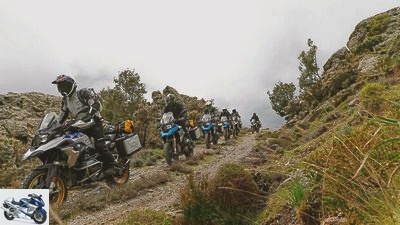
In the field, Michelin’s wild anakee shows the competition what’s going on.
There is no clear definition of off-road. For some, the adventurous off-road trip begins on the agriculturally used tractor lane in the neighboring town, while others do not begin under the old Dakar tracks in the Moroccan desert sand. In Sardinia we will probably find the perfect compromise from all worlds: dusty dirt roads, loamy goat paths through the evergreen macchia, stony scree slopes that get lost in the nowhere of the mountains.
According to the motto “Where there is no sign, there no judge”, we repeatedly beat ourselves offside with the six GS-s and let ourselves be dragged – just after our nose, the sun as a fixed point, because maps, but also Google Maps, have long been available given up. At this moment, the R 1250 GS with the ingenious Shiftcam motor and the “Enduro Pro” setting option, which is factory-set for the use of coarse off-road tires, proves to be an almost ideal test tool.
The all-terrain boxer can be maneuvered over hill and dale effortlessly and effortlessly, almost on the verge of being a trial bike. The big enduro even masters incredibly steep scree slopes, as if sliding down a feather-light crosser. So these are perfect conditions to concentrate on the differences in the tires. Depending on the subsurface, they also come to light. As expected, the three pairings that have previously proven to be particularly bitchy on solid ground – i.e. the street – are now triumphing. You pull the cart (and so many desperate pilots) out of the mud with a star plus award, so to speak.
Off-road motorcycle tires in the wet test
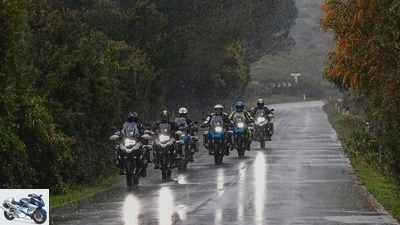
The Anakee Wild gives up very quickly when wet. The performance of Pirelli and Metzeler is flawless with a full grip pad and an easily assessable limit range.
Of course there are enough driving situations, there is – from a purely physical point of view – even the best rain tire with its Latin at the end: wet manhole covers, bitumen strips, tram rails, steel bridge heels … If you move here, you shouldn’t chalk that on the tire. That is why we test how the six tires handle normal driving situations on asphalt.
Place of the wetness test for the tires 2019: the test area of Bridgestone near Rome, where we can use a permanently watered circuit for two days. Rain on demand, so to speak, with the advantage that the water film is always evenly distributed over the asphalt surface and further disruptive influences such as poor visibility due to spray and raindrops on the visor are excluded. Almost all tire manufacturers operate similarly designed systems, a home advantage of their own tire brand through a special route or specially prepared asphalt is virtually impossible and would not work at all in practice.
Of course, within the framework of this laboratory-like curve discussion, we are at the highest theoretical level. In practice, even our most accomplished test driver would not think of bringing the tire to its grip limit, as is the case here on the test lap. After all, who can rule out the imponderables that can suddenly come across on the street??
However, it is only through this test procedure, which is more or less standardized by MOTORRAD, that precise statements about “what if …” can be made. If, for example, emergency braking has to be initiated in the rain!
Off-road motorcycle tires in the wear test
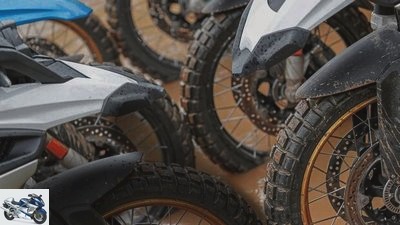
The softer off-road tires wear out faster than the more road-oriented treads? Puff cake. The Conti TKC 80 wins the wear and tear, and Bridgestone’s AX 41, like the Mitas E-07 +, is also good at it.
We all know and love the tuning factor “new tires”. The old skins have ridden down, are angular, angular and anything but supple. Then this feeling of rolling back onto the road with freshly baked goods – unique, isn’t it? But not so with our off-road tires. In principle, they are like good wine; they have to mature on the bike. Or comparable to hiking boots – they take time to wear them in. When new, the very terrain-oriented tunnel profiles in particular bring some pilots to despair by stubbornly resisting the dynamic curve or walking uncomfortably over the long lugs. Only when the hard cleat edges have been sanded for several hundred kilometers does it run much smoother. In general, as a preliminary remark to all those who, after this test, pluck the road-oriented series tires off their travel enduro bikes and happily pull up a coarse truck. Give yourself and the tire time to get used to each other.
This is how MOTORRAD tests tire wear: For wear and tear, we ride the same six bikes with different tires in a fixed column order. All motorcycles are swapped regularly so that driving differences can be balanced out. Nevertheless, we avoid wild hara-kiri actions, such as hard anchoring in and accelerating out of curves and bends. Anyone who knows group rides knows what happens then: the famous accordion effect … And that would greatly falsify the results, because exactly the required uniformity of the load can then be trashed. Ridden solo, the results would generally be reversed: the front mileage would decrease significantly faster than the rear. And all in all, you would have to reckon with significantly higher abrasion on a 1,500-kilometer tour.
However – the advantage of our method – only then can all tires be compared with one another, and the measured values can be related to one’s own experience. Incidentally, apart from MOTORRAD, no other editorial team in the world makes this effort. And we’re a little proud of that.
The motorcycles in the tire test
With the new large enduros, the tire size 120 / 70-19 (front) and 170 / 60-17 (rear) is the measure of all things, although the older 110 / 80-19 and 150 / 70-17 sizes are still widespread . The new developments of the tire manufacturers are increasingly tailored to the wider sizes, which is why we have to use the corresponding new vehicles for tests of this type, which are also available in the corresponding number (seven bikes are required for this test alone!).
Related articles
-
Road tires 2019 for large travel enduros in the test
Markus Jahn 17th pictures Markus Jahn 1/17 Which tire pairing has the edge after the tour over streets of all stripes?? Markus Jahn 2/17 If you value…
-
markus-jahn.com 28 pictures markus-jahn.com 1/28 Whether with a growling boxer or a yapping terrier: the MOTORRAD tire test causes the big tremors in the…
-
Concept comparison of enduro vs. off-road tires
Markus Jahn 14th pictures Markus Jahn 1/14 Is every rough hunter an off-roader? How many off-road genes are there in typical enduro tires? In the third…
-
Enduro tires tested 110-80 R 19, 150-70 R 17
markus-jahn.com 34 pictures markus-jahn.com 1/34 Enduro riding … markus-jahn.com 2/34 Especially during the wet test, the GS rolled out with a…
-
Buying tip tire test part 3 large enduro tires Dunlop Trailsmart
mps studio accesories tire Buying tip tire test part 3 large enduro tires Dunlop Trailsmart Best purchase tire test part 3 Dunlop Trailsmart Best choice…
-
Buying tip tire test part 3 large enduro tires Continental TKC 70
mps studio accesories tire Buying tip tire test part 3 large enduro tires Continental TKC 70 Buying tip tire test part 3 Continental TKC 70 Great mix of…
-
Enduro tires in the 2013 tire test
Jahn 44 pictures Jahn 1/44 Tire test 2013: 6 pairs of enduro tires: 110/80 R19, 150/70 R17. Jahn 2/44 Six enduro tires in country roads, wet conditions…
-
Test winner sports tires (MOTORRAD 13-2013)
Jahn 23 pictures Jahn 1/23 The 2013 MOTORRAD sports tire test. Jahn 2/23 The sports tires on the country road and motorway. Jahn 3/23 Where did the…
-
Sports tires in the 2013 tire test
Jahn 23 pictures Jahn 1/23 The 2013 MOTORRAD sports tire test. Jahn 2/23 The sports tires on the country road and motorway. Jahn 3/23 Where did the…
-
Sports tires 120-70 ZR 17 and 190-55 ZR 17
Jahn 49 pictures Jahn 1/49 Johannes Muller (30), MOTORCYCLE intern: As the youngest, he moves the oldest iron: CB 750 Four. Jahn 2/49 Lock-it tank bag…